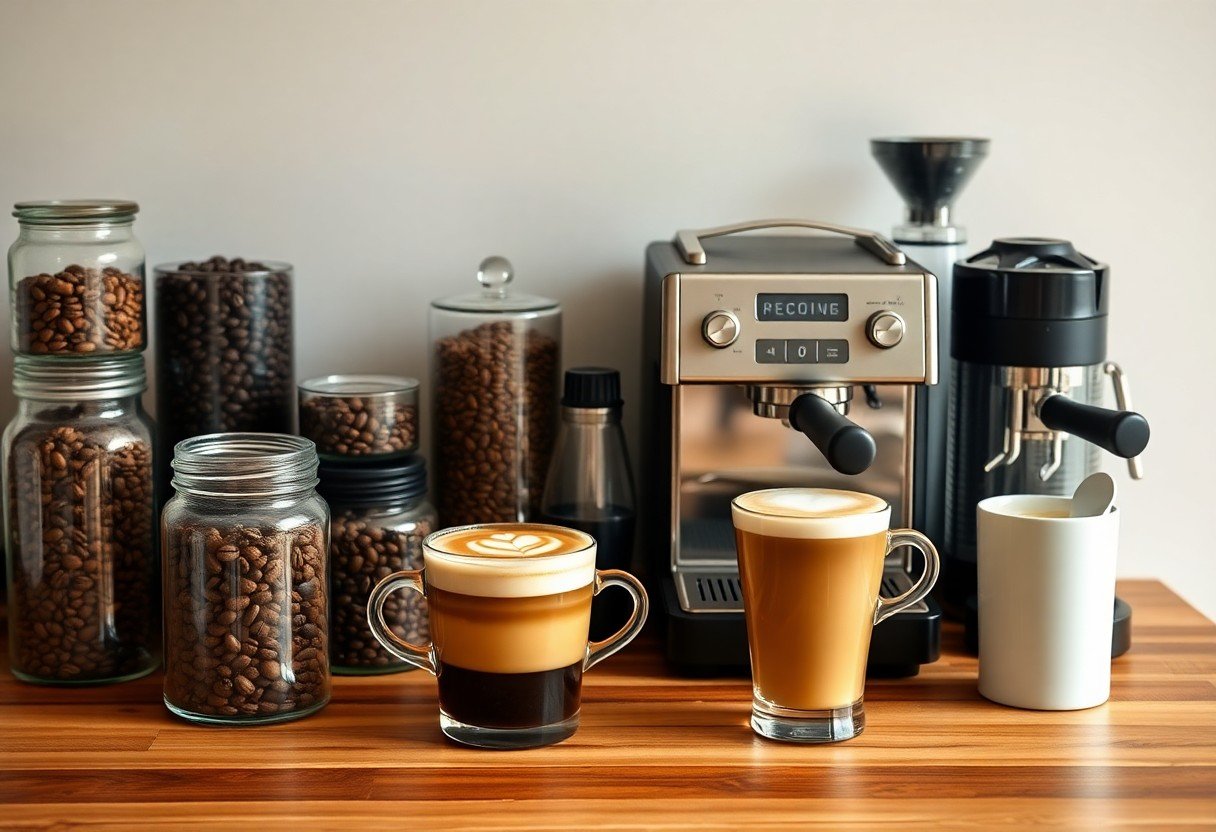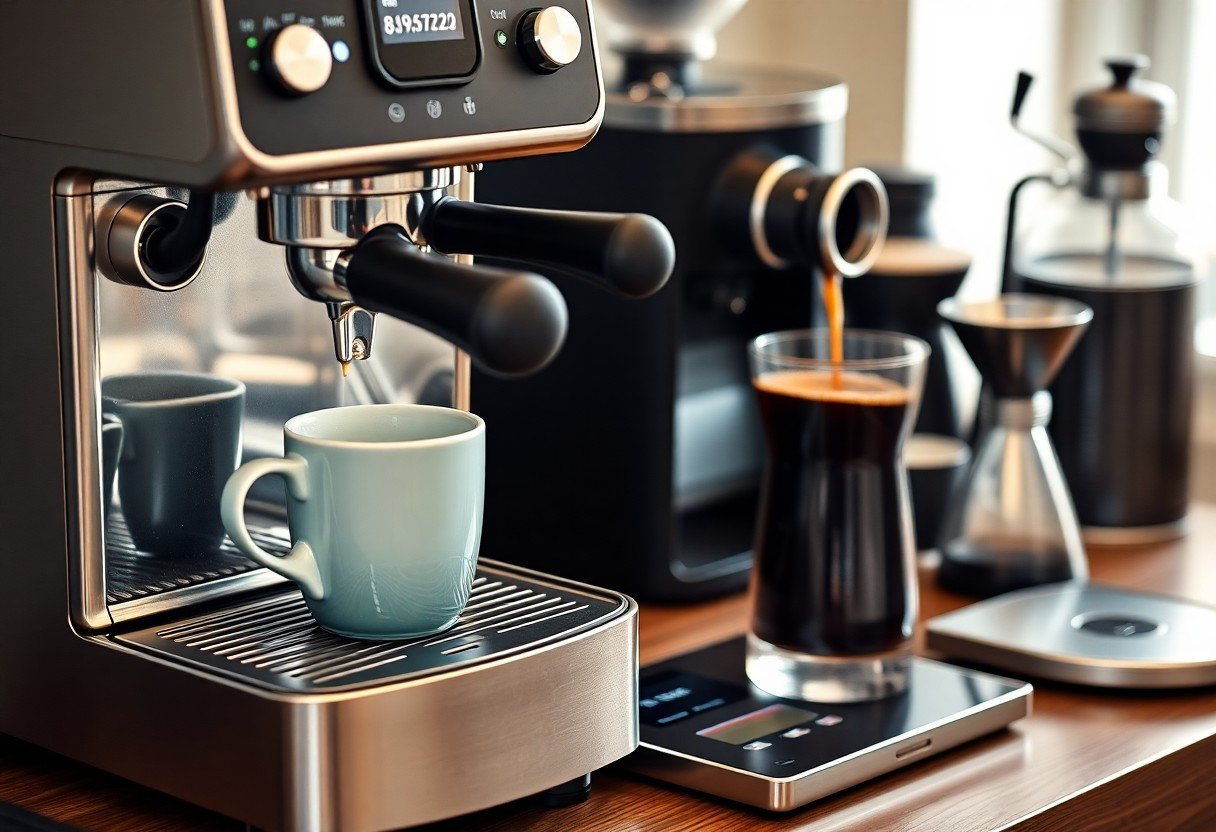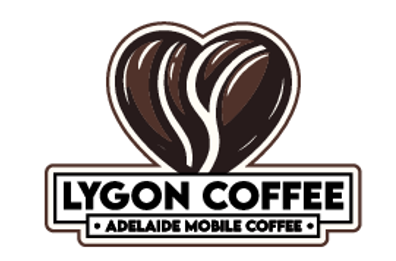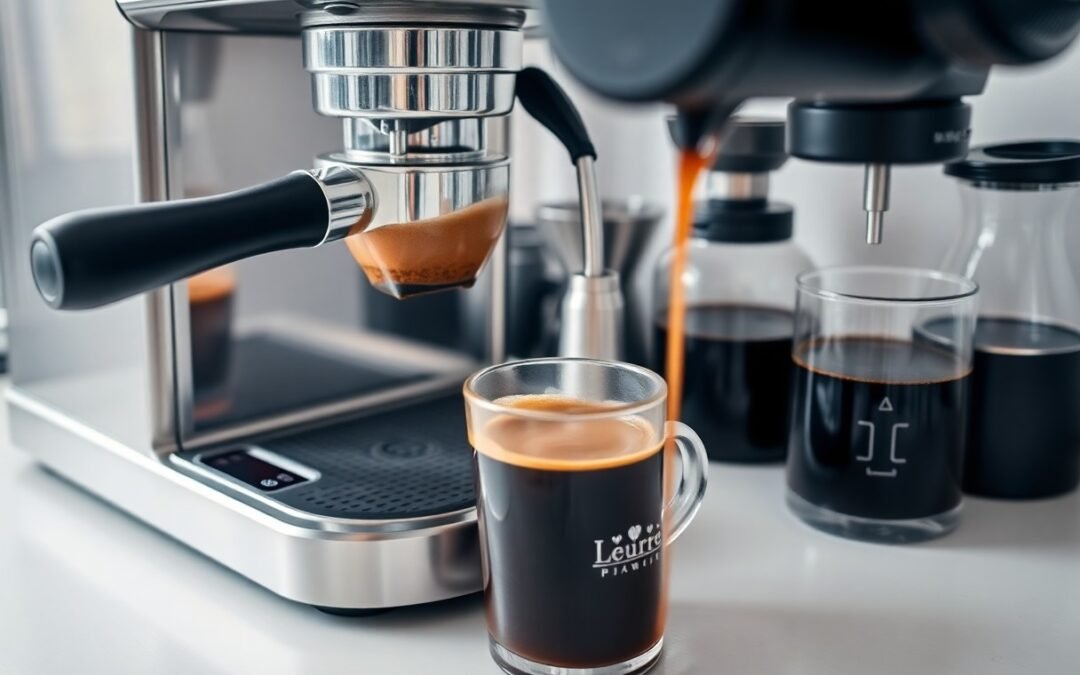Over the past decade, home brewing has transformed from a simple morning routine into an art form that any coffee lover can master. You have the power to elevate your daily brew with a few imperative tools, techniques, and insider knowledge, allowing you to enjoy café-quality coffee right from your kitchen. This guide will equip you with indispensable skills and tips that will not only enhance your brewing experience but also impress your friends and family.

The Art of Coffee Selection
Selecting the right coffee beans is a fundamental skill for any home barista. Your choice can transform an ordinary brew into an extraordinary experience. Focus on the origin, flavor profile, and roast type to find beans that resonate with your personal taste. Experiment with various options and don’t hesitate to explore different roasters to discover what suits your palate best.
Navigating Roast Types: From Light to Dark
Understanding roast types helps you select a coffee that complements your brewing method. Light roasts are fragrant, highlighting floral and fruity notes. Medium roasts strike a balance, showcasing both acidity and body. Dark roasts, with their bold flavors, often present chocolatey or smoky undertones. Each roast impacts extraction and flavor, so choose wisely based on your brewing preference.
- Light Roast: Bright acidity, floral notes
- Medium Roast: Balanced flavors, moderate acidity
- Dark Roast: Bold, rich flavors, low acidity
- Flavor Profiles: Influence your overall brew experience
- Perceiving subtle differences enhances your brewing skills
| Roast Type | Flavor Characteristics |
| Light Roast | Fruity, floral, bright acidity |
| Medium Roast | Nutty, balanced sweetness, mild acidity |
| Dark Roast | Chocolatey, smoky, bold |
| Brewing Method | Extraction varies by roast type |
Direct Trade vs. Commercial Brands: What Matters
Choosing between direct trade and commercial brands influences not just flavor, but also ethical considerations. Direct trade typically ensures better compensation for farmers, leading to higher quality beans. Conversely, commercial brands may source beans in a less transparent manner, often prioritizing price over quality. Understanding the source of your coffee can profoundly enhance the experience and support sustainable practices.
Essential Gear: Building Your Perfect Setup
Creating your ideal home barista station requires the right gear to ensure consistency and quality in your brews. A well-curated setup will help streamline your process, making it easier to craft café-quality beverages daily. Pay attention to the vitals, as well as consider advanced tools that can enhance your experience and elevate every cup.
Must-Have Equipment for Every Home Barista
Your brewing experience starts with key pieces of equipment that every home barista should have. These vitals form the foundation for great coffee, enabling you to explore various brewing methods and perfect your skills.
| Coffee Grinder | Ensures freshly ground beans for maximum flavor. |
| Coffee Maker | Choose between drip, pour-over, or espresso machines. |
| Scale | For precise measurements of coffee and water. |
| Kettle | A temperature-controlled kettle enhances brewing accuracy. |
Advanced Tools: Elevating Your Brew Game
Once you have the foundational equipment, consider adding advanced tools to enhance your home brewing. These tools not only improve the quality of your coffee but also offer more control over the brewing process, allowing you to experiment and refine your technique.
| Espresso Machine | Transforms your setup with the ability to create authentic espresso. |
| Milk Steamer | Perfect for crafting lattes and cappuccinos. |
| Coffee Siphon | Offers a unique brewing method that is visually impressive. |
| Tamper | Essential for packing grounds evenly in espresso brewing. |
Advanced tools can significantly enhance your brewing experience. An espresso machine allows you to manipulate pressure and temperature settings, while a milk steamer adds the flair of café-style drinks. A coffee siphon creates an engaging brewing experience, producing a clean and crisp coffee. Investing in these tools not only elevates the taste but also your barista skills, leading to newfound creativity and satisfaction in every cup.
- Invest in a quality espresso machine for versatility.
- Consider a milk frother for specialty drinks.
- Explore different brewing methods with a siphon.
Mastering Brewing Methods: Techniques for Every Palette
Exploring various brewing methods is key to unlocking diverse flavor profiles and achieving the perfect cup. Experimenting with techniques like the French press, pour-over, and espresso allows you to cater to your unique taste preferences while enhancing your skill set as a home barista. Understanding each method’s intricacies will elevate your brewing game, turning your daily ritual into an artful experience.
The French Press: Simple Yet Elegant
The French press combines simplicity with elegance, extracting rich, full-bodied flavors from your coffee grounds. By steeping coarse grounds in hot water and then pressing down the plunger, you create a robust brew that captures crucial oils and aromas. This method’s straightforward approach allows you to customize steeping times and ratios, ensuring each cup meets your personal taste.
Pour Over Precision: A Ritual for Connoisseurs
Pour-over brewing represents a meticulous art form, demanding attention to detail for the best results. By slowly pouring hot water over coffee grounds, you control extraction, achieving clarity and nuanced flavors. This hands-on method rewards patience and precision, allowing you to fine-tune your technique to match your palate perfectly.
Mastering the pour-over technique requires a few crucials: a gooseneck kettle for accuracy, a quality scale for measuring coffee and water, and a timer to track your brewing time. Aim for a coffee-to-water ratio of 1:15, adjusting to your preferred strength. Begin with a bloom phase, wetting the grounds for 30 seconds before continuing your pour, ensuring a balanced extraction. This ritual not only enhances flavors but also transforms your brewing into a thoughtful experience.
Espresso Technique: Crafting Café Quality at Home
Crafting espresso at home empowers you to recreate café-quality beverages with precision. Mastering this method involves honing your grind size, tamping pressure, and brewing time to generate the perfect shot, characterized by its rich crema and robust flavor profile. A quality espresso machine and grinder are crucial tools for achieving consistency and depth in your coffee.
To create an exceptional espresso, focus on using fresh, finely ground coffee and a tamp that applies uniform pressure to the grounds. Water temperature between 195°F and 205°F aids optimal extraction. A brew time of 25-30 seconds will yield a well-balanced shot. Experimenting with different beans and blends further allows you to customize your espresso experience, bringing the café vibe right to your kitchen.
Flavor Fundamentals: Crafting a Signature Brew
Crafting your signature brew comes down to understanding the imperative elements that contribute to flavor. Emphasizing balance and complexity involves exploring grind size, water quality, and the ratios you employ. Each factor interacts dynamically to elevate your daily cup, allowing you to tailor your coffee experience to match your taste preferences. With a bit of experimentation and knowledge, you can unlock the full potential of each ingredient to create a brew that is uniquely yours.
The Importance of Grind Size and Consistency
Grind size directly influences extraction rates, impacting overall flavor. Finer grounds increase surface area, leading to a quicker extraction and often bolder flavors, while coarser grounds result in a slower extraction, yielding milder profiles. Consistency in grind is equally vital, as uneven sizes can lead to both over-extraction and under-extraction, diminishing the quality of your brew.
Water Quality: The Most Overlooked Ingredient
Poor water quality can sabotage even the highest-quality beans. Using filtered water can enhance clarity and ultimately highlight the coffee’s unique flavors, whereas hard or unfiltered water may introduce unwanted minerals and flavors. The pH level and mineral content of your water significantly shape your coffee, making it imperative to choose your water wisely for the best results.
Investing in water filtration can dramatically improve your brew quality. Aim for water with a balanced mineral content, ideally around 150-250 ppm for optimal extraction. Distilled water, while pure, can lack the necessary minerals for flavor enhancement. Instead, consider using spring water that provides a clean profile while retaining imperative minerals, setting the stage for a vibrant coffee experience.
Experimenting with Ratios: Finding Your Sweet Spot
The coffee-to-water ratio can make or break your brew. Finding your sweet spot often requires testing different ratios to see how they affect flavor and strength. A standard starting point is 1:15 (one part coffee to fifteen parts water), but personal preference can lead you to adjust this anywhere from 1:14 to 1:18, especially as you refine your taste over time.
To uncover your ideal ratio, try brewing successive cups, gradually adjusting the amount of coffee and water. Take notes on each attempt, noting the nuances in flavor that emerge with each variation. This approach not only helps you find what you enjoy but also deepens your understanding of how different ratios impact the final taste of your coffee, paving the way for a more tailored brewing experience.

From Bean to Cup: Brewing Science Unleashed
Understanding the science behind coffee brewing transforms your daily cup into a remarkable experience. By grasping the foundational elements of extraction, temperature, and timing, you can tailor each brew to highlight unique flavors and aromas in your selected beans. This knowledge enables you to experiment and refine your technique, elevating what once was a mundane ritual into a mindful exploration of taste and quality.
Temperature and Extraction: The Science Behind Taste
Water temperature plays a pivotal role in coffee extraction, influencing the solubility of various compounds within the beans. Optimal brewing temperatures typically range between 195°F to 205°F. Below or above this range, you risk under-extracting or over-extracting your coffee, leading to unbalanced flavors. Understanding this delicate relationship empowers you to manipulate taste effectively, ensuring a consistently enjoyable brew.
Extraction Variables
| Temperature Range | Effect on Flavor |
|---|---|
| Below 195°F | Under-extraction, sour or overly acidic notes |
| 195°F – 205°F | Optimal extraction, balanced sweetness and complexity |
| Above 205°F | Over-extraction, bitter flavors and harshness |
Understanding Brewing Times: Patience Pays Off
Timing significantly impacts the final flavor profile of your coffee. Different brewing methods require specific steeping durations to optimize extraction of flavors from the coffee grounds. For instance, a French press typically requires a four-minute steep, while an espresso shot extracts in just 25 to 30 seconds. Mastering these times ensures you capture the beans’ full essence, resulting in a more satisfying cup.
Each brewing method has its own optimal steeping time, which greatly affects extraction. For drip coffee, a duration of four to five minutes extracts the vital oils and sweetness, while methods like pour-over demand precise timing to achieve a balanced cup. Deliberate experimentation with brewing times can reveal inherent flavor profiles unique to each bean, allowing you to dial in your preferences. This patience in brewing can make a world of difference in flavor complexity and overall satisfaction in your daily coffee rituals.
To wrap up
From above, you have explored the important techniques and tools that will transform your daily coffee routine into an exceptional experience. By integrating precise brewing methods and quality ingredients into your practice, you can elevate your coffee game from ordinary to remarkable—all from the comfort of your kitchen. Embrace the journey of becoming your own home barista, and enjoy the satisfaction of crafting a perfect cup tailored to your taste. Your daily brew deserves the elevating touch of your newfound skills.
FAQ
Q: What is “The Home Barista’s Guide”?
A: “The Home Barista’s Guide” is a comprehensive resource designed for coffee enthusiasts who want to enhance their brewing skills at home. It covers various techniques, equipment, and tips for producing high-quality coffee beverages without needing to visit a café.
Q: What topics are covered in the guide?
A: The guide includes sections on different brewing methods, espresso-making techniques, milk frothing, flavor profiling, and equipment recommendations to help you create café-style drinks in the comfort of your kitchen.
Q: Is the guide suitable for beginners?
A: Yes, the guide is suitable for all skill levels. Beginners will find clear, step-by-step instructions, while experienced baristas can discover advanced tips and techniques to refine their skills.
Q: What equipment do I need to get started?
A: To start brewing like a barista, you will need a coffee grinder, a brewing device (like a French press or espresso machine), a scale for measuring coffee grounds, and accessories like a milk frother and thermometers for precise brewing.
Q: How can this guide help improve my coffee flavor?
A: The guide focuses on the importance of coffee bean selection, grind size, water temperature, and brewing time, all of which contribute to flavor. By following the tips and techniques outlined, you can achieve a more balanced and enjoyable coffee experience.

